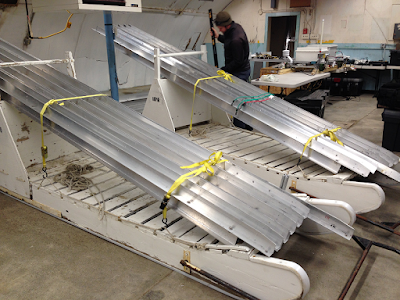Field research for the NGEE Arctic team is off to an early
start. There have been, and currently are, team members conducting snow surveys
at our field sites on the Seward Peninsula. And there have been plenty of
preparations for field studies on the North Slope as well. This week, Bryan
Curtis (LBNL) and I travelled to Barrow for a number of activities; foremost
among them was the reinstallation of the tram on the Barrow Environmental
Observatory (BEO). We had disassembled the tram last fall and moved all the
infrastructure and cart to storage facilities. This was done for several
reasons, one being to remove the physical infrastructure from the field so that
it did not pose a safety risk to local people who might traverse the BEO using
snow machines during the winter. Another was to continue to upgrade the suite
of sensors on the cart which required it to be shipped back to LBNL.
Our first task in Barrow was to transport all the uprights
and supporting rails from storage to the field site several kilometers away.
This was done by loading the materials onto wooden sleds and then transporting
everything to the field using snow machines. Although much of the tram is
constructed of aluminum, it is still heavy and required multiple trips to and
from the field before everything was in place. It was cold with high winds in
the afternoon. However, the weather cooperated and we had plenty of daylight
for moving materials to the field.
When Bryan and I were not transporting materials to the
field, the sensor cart was assembled and all components were tested including
sensors, data logger, and control programs. This required several days of
effort but no surprises due to careful planning by Bryan and others at LBNL.
Once everything was in the field it was just a matter of
getting everything installed. The system was designed for ease of installation
and thanks to the carefully planning by a number of people, including systems
engineer Keith Lewin at Brookhaven National Laboratory, the uprights and raised
rails were up, leveled, and ready for testing with only two days of effort.
The cart was the last thing to be transported to the field,
and it too was easy to install. Once all the sensors had been connected the
system was ready for testing. Everything worked perfectly! The cart made its
maiden 2016 trip down the rails on April 20, collecting data every 0.5 meter
along the 65-meter length of the tram.
Bryan will be keeping an eye on the system as he, and Sigrid
Dengel (LBNL) now turn their attention to getting the eddy covariance system up
and running. John Peterson and Emmanuel Legger, both from LBNL, will also be
joining Bryan and Sigrid for a few days in order to reinstall the geophysics
(ERT) array and take a few permafrost cores for physical characterization.
It was a great trip – thanks!






